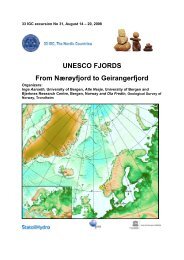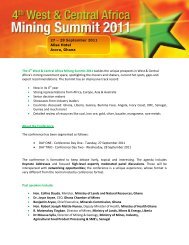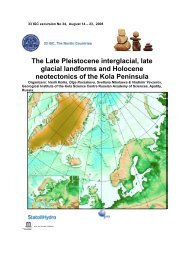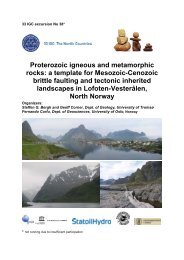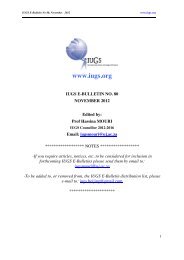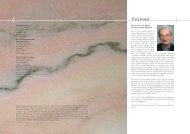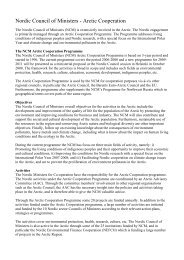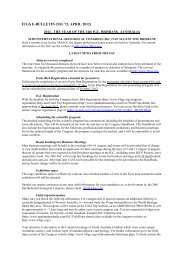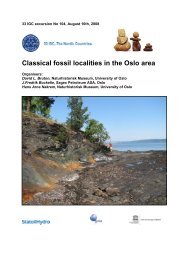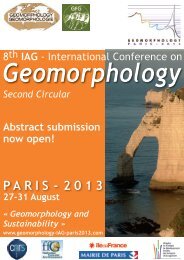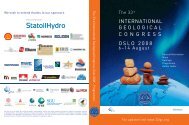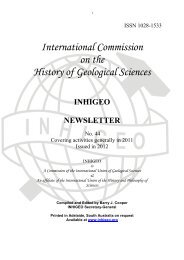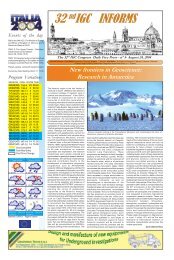The Second International Geological Congress, Bologna, 1881 - IUGS
The Second International Geological Congress, Bologna, 1881 - IUGS
The Second International Geological Congress, Bologna, 1881 - IUGS
Create successful ePaper yourself
Turn your PDF publications into a flip-book with our unique Google optimized e-Paper software.
14<br />
Figure 1a Giovanni<br />
Capellini, President of<br />
the <strong>Second</strong> <strong>International</strong><br />
<strong>Geological</strong> <strong>Congress</strong>.<br />
3 <strong>The</strong> questions placed before the<br />
Paris <strong>Congress</strong> be reported on at the<br />
<strong>Bologna</strong> <strong>Congress</strong>, having been studied<br />
in the interim by two international Commissions,<br />
one for the unification of geological<br />
symbols (A.R.C. Selwyn, President;<br />
E. Renevier, Secretary), the other<br />
for the unification of the geological<br />
nomenclature (E. Hébert, President; G.<br />
Dewalque, Secretary). Members representing<br />
the participating countries be<br />
named to the Commissions, and that this<br />
membership be augmented by representatives<br />
of countries not present at the<br />
Paris <strong>Congress</strong>, and the country-members<br />
designated set up a local Committee<br />
to report to the international Commissions.<br />
<strong>The</strong> reports prepared by the two<br />
Commissions, together with those of the local Committees, reach the<br />
Organizing Committee by January 1st, <strong>1881</strong>, so as to be printed and<br />
distributed before the opening of the <strong>Bologna</strong> <strong>Congress</strong>.<br />
4 A [French] Commission be established to study the question<br />
of common rules for establishing the nomenclature of species in both<br />
palaeontology and mineralogy. (Translated by the present writer).<br />
Ellenberger (1978) acknowledged these same outcomes of the<br />
Paris <strong>Congress</strong>, adding critically that the <strong>Congress</strong> had failed<br />
as a mechanism for methodologically confronting the work and<br />
problems then facing the geological community of the world. No<br />
international geological exhibition was assembled, the times allotted<br />
for papers and discussions were far too limiting, national representation<br />
was very much out of proportion, the themes proposed were<br />
often hardly touched upon and were at times replaced by widely disparate<br />
presentations of variable scientific interest (p. 24).<br />
An additional remark that “several of the major contemporary<br />
areas of dispute were not covered” (Ellenberger, 1978, p. 24) seems<br />
excessively harsh, or even unjustified, criticism because the stated aim<br />
of the first IGC was “the settling of many obscure points relating to geological<br />
classification and nomenclature,” as requested by the Philadelphia<br />
Founding Committee (Mendenhall, 1877, p. 355; Vai, 2002).<br />
<strong>The</strong> speeches given in Paris by James Hall and Joachim Barrande,<br />
the two leading palaeontologists attending the <strong>Congress</strong>, are<br />
worthy of mention. Hall, Capellini’s good friend since 1863, lucidly<br />
expressed his view on the comparative correlation method in stratigraphy,<br />
which was based on a number of principles, including priority,<br />
that are still hold to be valid. Hall’s remarks, therefore, were<br />
fully in keeping with the objectives of both the Founding Committee<br />
and the <strong>Congress</strong> itself (Anonymous, 1880, p. 60-67). Barrande,<br />
praising the American stratigrapher, criticized “our teachers Murchison<br />
and Sedgwick,” who “had neglected palaeontology.” He emphasized<br />
the value of his own major faunal units, and pronounced the<br />
“discussions on nomenclature to be completely useless” (Anonymous,<br />
1880, p.101-106). This view anticipated the approach of the<br />
bio-ortho-chronological German school that still has some supporters<br />
and strongly contrasts with the pragmatic stratigraphic approach<br />
introduced at the <strong>Bologna</strong> IGC and followed subsequently by the<br />
majority of stratigraphers. In any case, it is not true to say that<br />
Murchison and Sedgwick (and especially Murchison) “neglected<br />
Figure 1b Felice<br />
Giordano, Secretary<br />
General, and<br />
Giuseppe Scarabelli,<br />
Treasurer, 2nd IGC<br />
<strong>Bologna</strong> <strong>1881</strong>.<br />
palaeontology”, though this was appropriate of Sedgwick’s early<br />
work in rocks that contained few easily found fossils.<br />
Organization of the <strong>Second</strong><br />
<strong>International</strong> <strong>Geological</strong> <strong>Congress</strong>,<br />
<strong>Bologna</strong>, <strong>1881</strong><br />
Thomas Sterry Hunt, who played a major role in both the Philadelphia<br />
Founding Committee and the 1st IGC, Paris, 1878, suggested<br />
that the 2nd IGC be held in <strong>Bologna</strong> under the presidency of<br />
Capellini. His suggestion was unanimously accepted by the Bureau<br />
and the Council and acclaimed by the General Assembly on September<br />
4, 1878 (Anonymous, 1880, 1882). Hunt knew very well that<br />
Capellini, being in agreement with the aims of the Founding Committee,<br />
was the man best able to mediate and succeed in the difficult<br />
task of establishing a common terminology for geology and geological<br />
mapping (Vai, 2002). Capellini, in turn, having contributed significantly<br />
to the adoption of the Paris resolutions, started work<br />
immediately. He completed the composition of the Organizing Committee<br />
(OC) (Figure 1b) by adding new members to the ten<br />
appointed at the Paris <strong>Congress</strong> and obtaining the ‘High Patronage’<br />
of King Umberto I of Italy, who, as a prince, had already attended in<br />
person the 5th <strong>International</strong> <strong>Congress</strong> of Anthropology and pre-Historical<br />
Archaeology, organized in <strong>Bologna</strong> by Capellini in 1871.<br />
Following Capellini’s proposals, the OC decided that a <strong>Geological</strong>-Palaeontological<br />
Exhibition should be held during the <strong>Congress</strong><br />
in the <strong>Geological</strong> Institute of <strong>Bologna</strong> University; that a volume containing<br />
a <strong>Geological</strong> and Palaeontological Bibliography of Italy be<br />
printed (Figure 2) and distributed to the attending members; and a<br />
logo for the IGC be adopted, with the Latin inscriptions Geologorum<br />
Conventus and Mente et Malleo inserted in a circle with two crossing<br />
hammers in the centre (Figure 3). <strong>The</strong> logo was accompanied by an<br />
emblem, distributed also as a badge and medal, showing the number,<br />
date, and venue of the <strong>Congress</strong>, with the<br />
coat of arms of the Kingdom of Italy and of<br />
the city of <strong>Bologna</strong> (Figure 4). Both were<br />
published as a frontispiece to the <strong>Bologna</strong><br />
Proceedings volume (Anonymous, 1882).<br />
An exciting account of how the logo was<br />
conceived is to be found in Capellini (1914,<br />
v. 2, p. 266-268). An estimated cost for the<br />
<strong>Congress</strong> was set at “50,000 lire” (about<br />
158,000 euros, the Italian lira being equivalent<br />
to the French franc at the time). Financial<br />
contributions came from the Italian<br />
Government, the King, and the City of<br />
<strong>Bologna</strong> and its Province, with Marco<br />
Minghetti and Quintino Sella (both future<br />
Prime Ministers of Italy) helping considerably<br />
(Capellini, 1914, v. 2, p. 266).<br />
<strong>The</strong> First Circular of the <strong>Congress</strong> was<br />
issued on April 30, 1879, more than two<br />
years before the convention was to open.<br />
<strong>The</strong> registration fee was set at 12 French<br />
francs, being equal to 3.86 g of gold<br />
according to Ellenberger (1978) or 12 lire<br />
for Italian registrants being equal to about<br />
38 euros. This was the level that had prevailed<br />
for the Paris <strong>Congress</strong> three years<br />
prior, and it proved adequate to supply each<br />
member with a copy of the Proceedings<br />
volume gratis and with other publications<br />
of the <strong>Congress</strong>.<br />
One year later the King of Italy<br />
granted the OC the sum of 6,000 French<br />
francs (about 19,000 euros) to encourage<br />
Figure 2 Frontispiece<br />
of the Bibliographie<br />
complimentary<br />
offered to the<br />
<strong>Congress</strong> members<br />
(Capellini Museum).<br />
Figure 3 General<br />
logo for the IGCs<br />
designed by Capellini<br />
(Anonymous, 1882).<br />
March 2004



